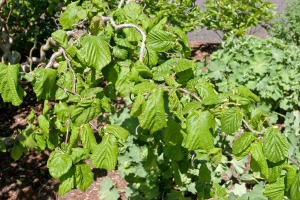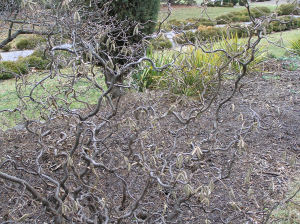Typically, when we think about plants for winter interest we think about evergreen trees or shrubs. But, there are other types of plants that give us an interesting appeal in the winter months when most plants are dormant. One of my favorite plants is at the top of my interesting plants list because of the unique branching habit, Harry Lauder's walkingstick.
Harry Lauder's walkingstick, Corylus avellana 'Contorta', is also known as contorted filbert and corkscrew filbert. It is a cultivar of the tree species European filbert and a close relative to American hazelnut and Turkish filbert. It is a small tree or large shrub that grows up to 8 feet in height and spread but can be kept smaller with pruning. Harry Lauder's walkingstick has very unique, curling and twisting branches, stems, and leaves. The rootstock of this grafted plant tends to sucker, which can be controlled easily with repetitive pruning of those sprouts. The leaves are alternate, simple, and 2-4 inches long and up to 3 inches wide. The leaves are hairy on the underside. Like the rest of the plants in the Birch Family, Harry Lauder's walkingstick has catkins, which are the spike-like, scaly structures that come from the flowers.
Harry Lauder's walkingstick grows best in full sun or part shade. It does well in most soil conditions, including poor soils and tolerates very dry soils. It is also a good plant that tolerates both high heat and wind locations. Harry Lauder's walkingstick does not tolerate poorly drained, or wet, soils, this plant would rather be in too dry than too wet of a location. It is best planted as a specimen small tree or large shrub as it is a piece of art on its own.
The main advantage of planting contorted filbert would be the winter interest. According to the University of Florida Extension, contorted filbert has persistent fruit that is enjoyed by birds, rodents, and humans. The form becomes dense and would therefore make a great habitat for wildlife in the winter months. Harry Lauder's walkingstick in winter.
Harry Lauder's walkingstick, contorted filbert, or corkscrew filbert, no matter what you call it you get a very unique plant. This is a great plant to utilize in any landscape to add winter interest. This would make a great small tree to plant outside your home so that during the winter you can look out and admire the unique, twisted, and curling branches to see something other than white and brown colors from the winter. It is adaptable to many different growing locations, just not poorly drained soils. So the next time you are looking to plant a new small tree or large shrub for winter interest, look to Harry Lauder's walkingstick. (The picture on the right is from Clemson Cooperative Extension)


